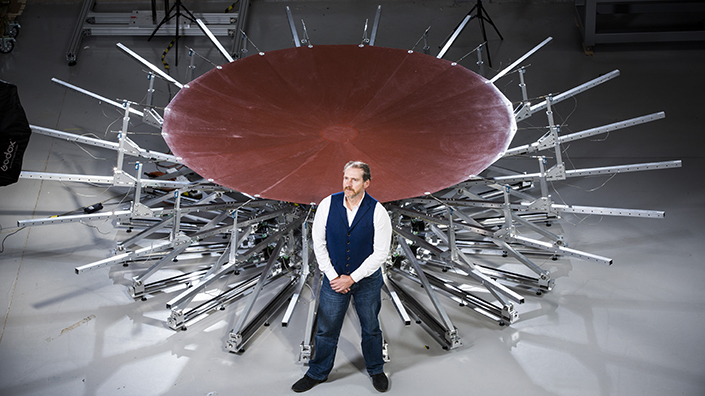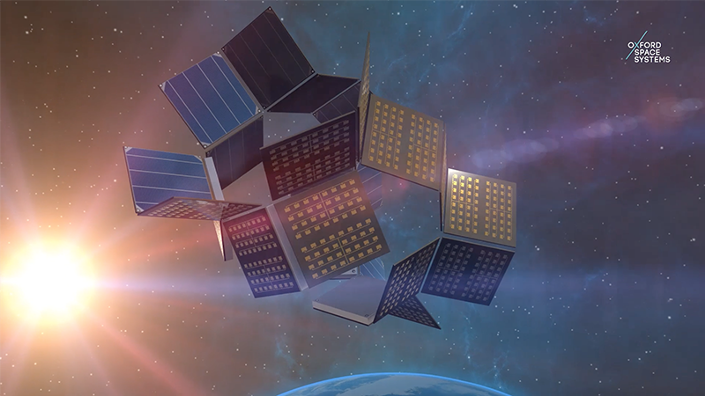The founder and chief executive of the £10m venture-capital-backed Oxford Space Systems (OSS) is right to be positive. His tools are lightweight and compact satellite antennas, booms and panels; the gold rush is ‘New Space’, and its prospectors are the companies and researchers around the world desperate to shave mass off launches and money off missions.
Oxford Space Systems aims to be the leading global supplier, and the boss says getting its products into a “mega-constellation” of hundreds of satellites is the “end game”. OSS also hopes for more British customers following the recent announcement of government support for a spaceport in the north of Scotland.
With the right government support, Lawton says the UK could be home to a breakthrough “Google of space”. “Having our own launch capability in the UK is a massive boost for the sector,” he says. “There is greater competition in the market to provide launch services… that translates into a great enhancement of the commercial environment, which means more satellites can be built, you can get into orbit quicker, which means demand for our technology looks like it can only increase.”
Croquet and composites
Harwell is a very British centre of world-leading space engineering. Here, the space shuttle is a bus, linking the 710-acre site with Didcot Parkway station. On arrival, two men are playing croquet between the entrance signs.
But there is nothing old-fashioned inside OSS, which has been a beneficiary of the IMechE’s £2m Stephenson Fund. Equations and diagrams are scrawled in blue and red across office walls, and Lawton quickly jumps into cutting-edge detail inside a meeting ‘pod’.
Satellite manufacturers have traditionally focused on the ‘bus’ of the spacecraft, he says – the infrastructure containing the expensive mission equipment. Deployable parts such as antennas and panels have been a secondary concern – but they are central for OSS, where the drive is to help manufacturers create the smallest possible satellites without compromising mission capability.
The company’s solution is ultra-compact technology made of flexible carbon-fibre composites. “They’ve been able to do things with materials that other people haven’t,” says Tony Mears, technology expert at the UK Space Agency. The company has experimented with different weave patterns, resins and curing techniques for its carbon-fibre materials, optimising them for different uses.
Hinges, boom arms and antennas are designed to be folded by hand with machine assistance on Earth, before deploying automatically in orbit thanks to their stored energy. So much energy is stored, in fact, that the speed of deployment for some structures must be limited to prevent satellites being knocked out of alignment. Eddy-current dampers generate magnetic fields that interact with components to cause drag, limiting their speed.
One upcoming OSS product is the wrapped rib antenna, which will have diameters of 1-5m. Carbon-fibre ribs will deploy out from the centre, presenting a surface of gold molybdenum metal mesh – Gold Moly, as OSS workers call it – or carbon fibre. The design will allow 5m antennas on satellites the size of washing machines, says Lawton.
The company is also working on a much larger antenna design that will permit diameters of up to 14m in orbit. The membrane surface will be predetermined on moulds, rather than stretched by the frame underneath, for simple deployment of accurate parabolic reflectors.

Testing is a key part of OSS work (Credit: OSS)
The surface is undergoing a battery of tests at the RAL Space facilities next door, including using a huge vacuum chamber to “simulate the depths of space”, a vibration table capable of creating 80G shocks, a computer-controlled folding test rig, and an electron microscope to check for the smallest faults and breaks after repeated folding and deploying.
The testing must be rigorous – in low Earth orbit the antenna will face constant and potentially harmful thermal cycling from 16 sunrises and sunsets per day, unwanted ‘cold metal welding’ that can fuse parts together in the vacuum of space, and atomic oxygen particles that smash into the carbon fibre, attempting to oxidise the material and erode it over time. As a result the antenna must be coated – including with nanomaterials such as graphene – to protect the structure from the harsh space environment.
Despite the great lengths taken to test and protect the technology, OSS is not aiming for everlasting orbit. Lawton says he has a “wry smile” when he hears about NASA spacecraft working 20 years after their planned lifetimes. “That’s why space is so damn expensive! Our technology is designed for fit-for-purpose, not technological perfection.”
Flat-pack satellite
Brexit is a “mixed bag,” says Lawton. As the UK is booted out of EU projects such as the Galileo alternative to GPS, the government will invest in sovereign capabilities. This will mean an increasing reliance on technology designed, developed and built in the UK, says Lawton. OSS fits the bill.
Back in February, the company had 22 employees. A few months later it has at least 30, and is preparing to expand further in a custom-built Harwell headquarters with security requirements ready for defence and sovereign applications.
The company is entering a new era, coming out of intensive R&D into wider commercialisation. Simple booms are in orbit already, and more devices will follow soon. But they won’t stop innovating, says Lawton.

A screenshot of an animated video showing the OrigamiSat concept (Credit: OSS)
The focus on R&D will decrease, he admits, but the company has to “stay ahead of the competition”. He reveals a potentially revolutionary satellite concept recently patented by the company. Based on the rigid panel origami of the University of Oxford’s Professor Zhong You – whose collaboration helped develop other OSS technology – the OrigamiSat is, says Lawton, “a completely unpackable satellite” using the same stored energy principle as the firm’s other devices.
A concept video shows two adjacent stacks of satellite panels in orbit, joined at the top and bottom. They unfold from the bottom, the two stacks rapidly becoming an accordion expanding in all directions. They extend fully down before the panels swing up to form a flat 24-piece satellite, with a patch-panel antenna on the Earth-facing side and a solar array on the other.
Lawton calls it an “IKEA satellite,” and, for OSS, it’s a small step towards providing not just deployable technology, but complete satellite buses as well. Until now, OSS has been providing the pickaxes, but in the future it could strike gold itself.
This week, we will also feature UK-based firms StratoBooster, Skyrora, Open Cosmos, Orbex, Reaction Engines and Thales Alenia Space as part of the Great British Space Age.
Content published by Professional Engineering does not necessarily represent the views of the Institution of Mechanical Engineers.